58- Lesser Scaup
59- Eastern Screech Owl
60- Long-Eared Owl
61- Barred Owl
62- Yellow-Bellied Sapsucker
63- Short-Eared Owl
64- Bufflehead
65- Northern Flicker
66- Purple Finch
67- Long-Tailed Duck (extremely difficult in Kane County)
The best bird on the above list is most certainly the most recent one, a female Long-Tailed Duck, found by a fellow Kane County birder, Marion Miller. It has been an unbelievable year for waterfowl in Kane so far, I hope it keeps up!
Anyways, on to a story from today (February 19th). I had one target bird for the day, a pair of Sandhill Cranes had been reported the last couple of days in northern Kane County, so I went up that way to look for them. Unfortunately, they did not show for me, so no #68 in Kane just yet. After that, I had no specific targets, but I thought since it was gorgeous outside (first time I've said that this year) and because I need gulls, I should try for gulls. Gulls were absolutely the least abundant species type on the Fox River today. Starting in Carpentersville, the top of the dam was still frozen solid, and I really didn't expect anything different. A couple of Bald Eagles were the highlight here. Next up, the Dundee area.
For the most part, the Dundee area of the Fox was also frozen solid, but a sliver of shoreline on the east side remained open. It was here that I found a lovely pair of adult Mute Swans, as they glided past and up-river. Nothing else was notable here, so it was off to South Elgin.
South Elgin Dam is my favorite stopover on the Fox River for gulls and waterfowl. Gull highlights here in the past include my lifer Iceland Gull and a Bonaparte's Gull. My waterfowl highlights here included my lifer White-Winged Scoter last spring and the Canvasbacks which show up annually, starting in mid-February. This year has been a brutal winter, and so thawing hasn't happened yet. The last couple of days however, have been above freezing. That being said, the top of the dam, where everything likes to congregate, was still frozen, but getting softer. Another two days and there would have been a considerable opening in the ice, but alas, we are destined for cold weather by early next week. No waterfowl or gulls were present other than the typical Common Goldeneye and Mallards.
After this, I wanted to see if maybe the Island Park area in Geneva still had a little magic left over, even after hosting as many as 7(!) White-Winged Scoters in the past two weeks or so. A Greater Scaup or a Ring-Necked Duck couldn't possibly be too much to ask for right? Wrong, but it was nice to see two White-Winged Scoters almost immediately after walking down to where they had been hanging out. I enjoyed some relatively close views, and then kept going south. When I came to the pedestrian bridge that went under the railroad tracks, I had another White-Winged Scoter fly past headed north. I watched it land, and then my attention was drawn to a mess of feathers on the snow and trail ahead. I discovered that a Mallard had been the unfortunate victim of an unknown predator. No tracks in the snow left me to wonder what might have gotten it. Those who wish not to see this, scroll down quickly to the next group of words.
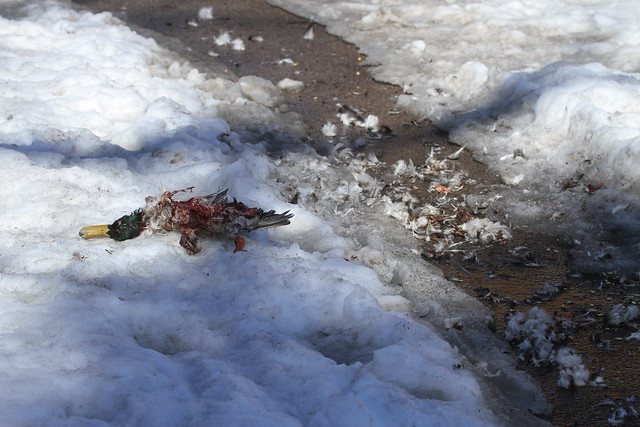 |
| Deceased Mallard |
After taking the above photo, I noticed that the Scoter that had flown past was now booking south on the current of the river. I realized it would pass directly underneath the pedestrian bridge, so I briskly walked back to the bridge so I could photograph it as it went by. But, it did not go by, it stopped. Pulling a u-turn, seemingly skating on top of the water, all progress ceased as it paddled only enough to stay in place against the current. I was not far away at this time. The bird began diving, but it was all happening in the shadows. There was one patch of the river where the sunlight was making it through a gap in the bridge enough to illuminate an area about 10 feet long by 30 feet wide. I could not believe my luck, as the Scoter swam into the sunlit portion, which was at most 25 feet away at any time from where I was. By far, it was the best looks I'd ever had at a Scoter. This bird was a poser!
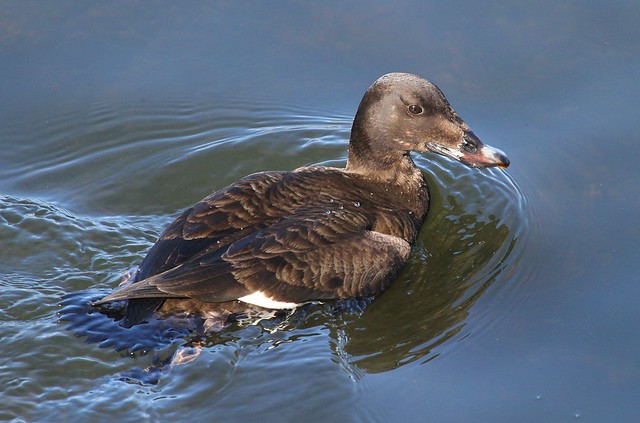 |
| White-Winged Scoter |
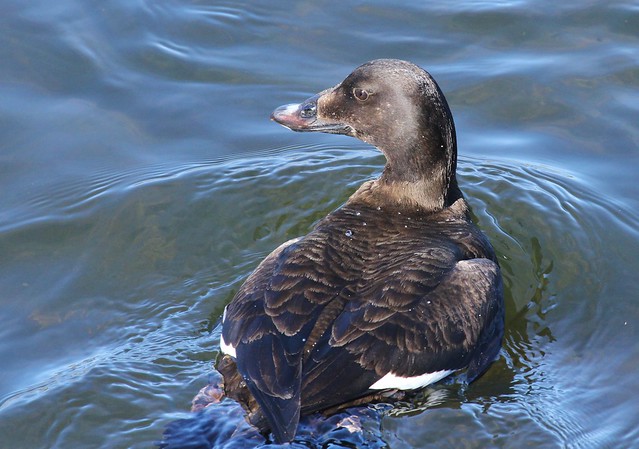 |
| White-Winged Scoter |
The Scoter then began diving again, and it was even better this time. I was above the bird on a bridge, and so I had an amazing vantage point that actually allowed me to see the bird while it was completely submerged!! The feet of the bird were brought out to each of its sides, paddling vigorously as it motored about underwater effortlessly, all the while working the bottom with its bill in much the same fashion as a Mallard does on the surface. What was most unexpected, was the way that the bird stood out underwater. Obviously, the bright white wing patches would stick out, but the whole bird actually had a faint whitish glow to it while it was underwater. I watched as the bird resurfaced time and time again, each time I knew exactly where it would come up before it did so. What an experience! And the photos weren't too bad either! Here are some photos showing the bird underwater, including a black and white photo.
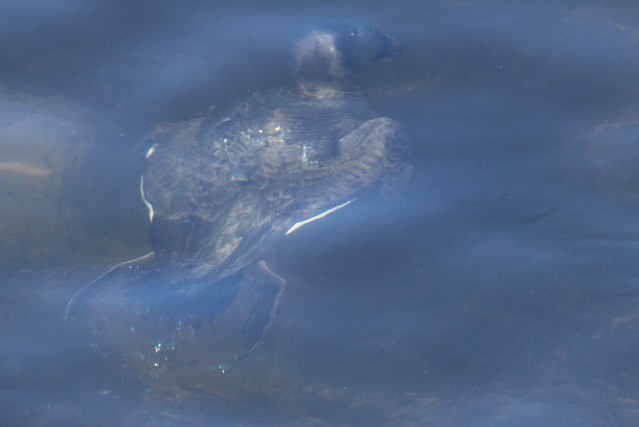 |
| White-Winged Scoter Underwater |
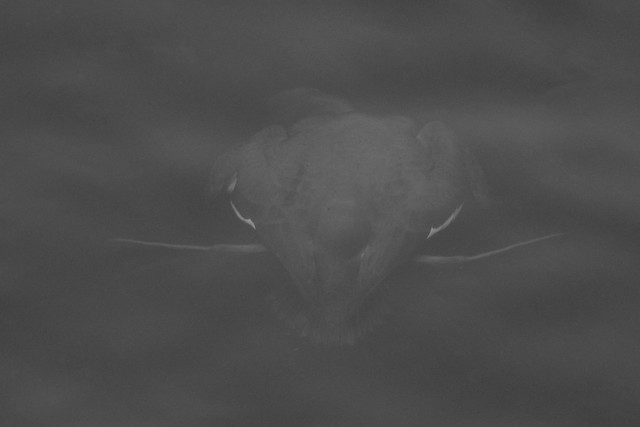 |
| White-Winged Scoter Underwater Black and White |
Another thing I noticed was when a train would pass by on the railroad bridge above us. Every time it seemed the bird was underwater when a train passed by, and every time I watched as all of the sudden the bird took off as quickly as a torpedo underwater, headed north. It would resurface about 30 feet away from where it was previously, but it always made its way back in close. All of this happened in about a half an hour of observation time, and the memories will last me for the rest of my life!! I left the bird in peace, quietly celebrating my experience and asking myself over and over. "Did that really happen for me?!" Unbelievable, and I also managed a great photo of a Common Goldeneye. That's also hard to do.
 |
| Common Goldeneye Banking |
I wrapped up my birding excursion in Batavia, where in 45 minutes of searching, I could not re-locate the female Long-Tailed Duck. All in all, great weather, great birds and great photos, add up to a satisfying day!
 |
| Common Goldeneye Drake |
Brendon Lake

No comments:
Post a Comment